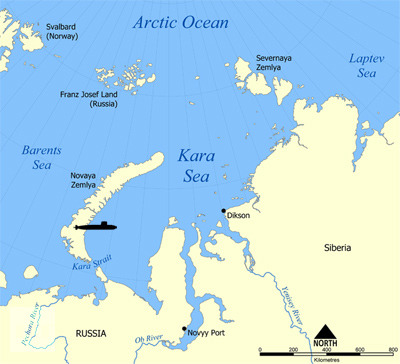I have blogged before about the nuclear waste situation in Russia. In one post, I discussed how Russia had been taking in illegal shipments of nuclear waste from European countries. I have also discussed how Russia has been dumping nuclear waste into the sea around the port of Murmansk. Now a report on the decades of Russian dumping into the Kara Sea of the Arctic Ocean has been provided by the Russians to the Norwegians. Norwegian officials are demanding high level talks with the Russians about their nuclear waste.
The catalog of dumped nuclear waste and reactors in the Kara Sea is much larger than thought by the Norwegian authorities and the Russian authorities. The known waste dumps include "seventeen thousand containers of radioactive waste, nineteen ships containing radioactive waste, fourteen nuclear reactors, including five that still contain spent nuclear fuel; seven hundred and thirty seven other pieces of radioactively contaminated heavy machinery, and the K-27 nuclear submarine with its two reactors loaded with nuclear fuel."
Given that the Soviets and the Russians kept poor records of nuclear waste dumping, it is likely that the catalog provided to the Norwegians is not complete. The Russians and the Norwegians have formed a task force to investigate the nuclear waste in the Kara Sea. The task force will send an expedition to the Kara Sea area where the Soviet and Russian waste has been dumped. The Russians are eager to explore the same area of the Kara Sea for possible oil production. Some see the Russian report provided to the Norwegians as a veiled plea for help because the Russians cannot handle their nuclear waste problems on their own. There were joint expeditions before in 1992, 1993 and 1994 to map the extent of nuclear waste in the Kara Sea but the new report shows that a lot of waste dumping was excluded from these earlier expeditions.
The K-27 submarine that was deliberately sunk in the Kara Sea in 1981 with two nuclear reactors full of spent nuclear fuel on board was not part of the initial report on nuclear waste that the Russians gave the Norwegians. Now it is being reported that it is possible that the spent nuclear fuel in the K-27 could achieve criticality and cause an explosion. The expedition will try to determine if the K-27 could be raised and whether or not it has been leaking radioactive materials.
The Soviet Union and Russia have a very poor record when it comes to keeping track of nuclear waste dumping. They also have a poor record when it comes to insuring the safety of people living in the areas where nuclear waste has been dumped. Unfortunately, the Russian are dedicated to the use of nuclear power at home and the export of nuclear reactor technology and nuclear fuel to foreign companies. They are building new fast breeder reactors with the intent of producing nuclear fuel to compete with uranium fuel in the international marketplace. I fear that the Russian people are not being told the real costs and real dangers of nuclear power generation.
Approximate location of the K-27 submarine:
